
Shipping:
Free Shipping Included
Delivery:
Estimated 2-15 Business Days
Payments:
Credit Card, Check, Cash, PayPal, Apple Pay, Venmo
Returns:
30 Days 100% Money Back Guarantee, Buyer Pays Return Shipping
Description
Vintage art nouveau / neoclassical style blue and white German jasperware porcelain plaque featuring a shield shape bordered in grape vines surrounding a female figure playing pipes or trumpets while a cherub dances. Attributed to Schafer and Vater.
“... Jasperware, ... is said to be Josiah Wedgwood's (1730-1795) greatest contribution to the history of ceramics. It is a fine stoneware that can have properties that resemble porcelain (yes, jasperware can be translucent), and Wedgwood called it ""his porcelain.""
Legend has it that Wedgwood started out his career at age 14 when he entered into partnership with the famous English potter Thomas Whieldon. Wedgwood went out on his own in 1759 when he began working a pottery located at the Ivy House Works in Burslem, Staffordshire, England. He moved to the Brick House Works in 1764, and finally, he built the Etruria factory, which opened in 1769 (some sources say it was 1766). Wedgwood worked for many years developing the jasperware body, and in 1774, he proclaimed it to be a body, ""of exquisite beauty and delicacy ... receiving colors through its whole substance in a manner which no other body ... has been known to do.""
It should be noted that jasperware came in a variety of colors (the one known as ""Portland blue"" is the most often found), shapes and neoclassical decorations in white. Jasperware was made with the color throughout the body or just on the surface. This later ware is known as ""jasper dip"" and can only be detected when a chip reveals the underlying whitish body.
Wedgwood is still making jasperware, and it is important to understand that not all Wedgwood jasper is signed. But there is absolutely no doubt that the two plaques in today's question are not products of the famous English factory. Instead, they were made many miles to the east, and most collectors call these ""German jasperware.""
Wedgwood's jasperware has raised decorations (usually white) that are made separately and applied to or sprigged onto the surface. German jasperware, on the other hand, looks something like this, but the object is molded as one piece with no applied decoration.
German jasperware is an imitation that lacks the artistry and attention to detail of real Wedgwood jasperware. Still, German jasperware can be very collectible, especially the examples with Cupids cavorting or vessels such as chocolate pots, vases and large plaques where the white, intricate figures (which are more art nouveau than neoclassical) seem to spring off the surface.
Condition
Good Overall - Gentle wear/a couple scuffs
Dimensions
5” x 0.75” x 7” (Width x Depth x Height)